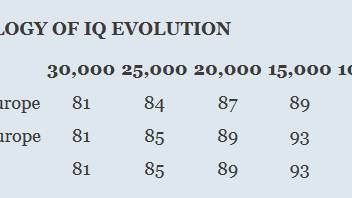The European Race Evolved in the European Continent - Relatively Recently
Source: eurocanadian.ca
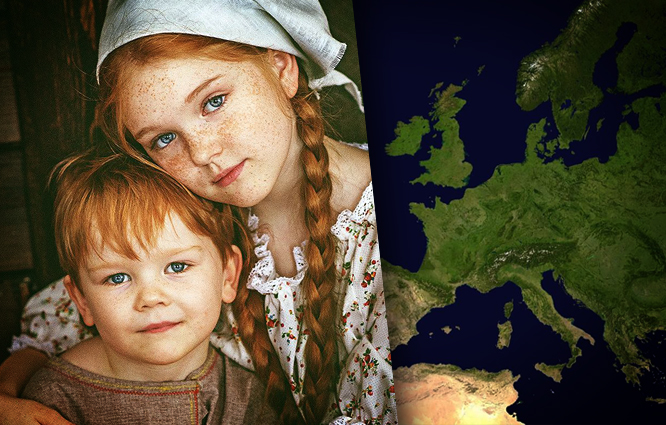
In the last few months a string of articles have appeared informing us about three major findings in the genetic history of Europeans:
- that it was not until about 5800 years ago that light-skin genes, as well as other genes for blue eyes and blonde hair, started to show up at a high frequency among the inhabitants of Europe.
- that mass migration of Bronze Age pastoralists from southern Russia contributed up to 50% of ancestry in some north Europeans.
- that the genetic make-up of the "people of the British Isles" has barely changed since 1400 years ago.
So, how is the cultural Marxist media handling these discoveries on the genetic history of the peoples of Europe? In this essay we will see that the mainstream media is willfully distorting the scientific content and political implications of these findings, all of which corroborate the long standing, but currently prohibited, argument that Europeans are a people with a strong racial identity based on genetic traits with a unique evolutionary history inside the continent of Europe.
Related: Scandinavians are the earliest Europeans - Genomic structure in Europeans dating back at least 36,200 years
When Europe became European?
Now, before I get into media distortions, something needs clarification regarding the way the racial and cultural term "European" is being used by all sides in this debate. The general wording in respect to the evolution of white skin, to start with, has been along the lines of "when or how Europeans evolved white skin". But the more accurate heading would have been: "when or how the inhabitants of Europe became European." Europeans emerged in time from a preceding people that were not European. This evolution, of course, was not simply a matter of when they evolved white skin; there were a number of other key traits, which did not emerge at once but through time, which means that it is difficult to state with any definiteness exactly when the inhabitants of Europe became "European".
The question is not when Europeans evolved x or y traits, white skin or lactose tolerance, since this way of framing the issue supposes that the inhabitants of Europe were European when Homo sapiens sapiens arrived in this continent some 40,000 years ago. We need to think of Europeans as a race that evolved through thousands of years inside Europe in response to the unique ecology of Europe and in response to their own unique cultural activities. The upper Paleolithic peoples who first inhabited Europe, coming from Africa via the Near East, were not Europeans but a people still closely descended from the African Homo sapiens sapiens who left Africa some 50,000 (or 60,000 years ago) and which long retained many African genetic traits.
To this day, it is common to identify the Upper Paleolithic of Europe peoples, point blank, as the "first Europeans", the "original Europeans of Europe". But the succession of European cultures witnessed during the long Upper Paleolithic epoch, the Aurignacian, which lasted from 45,000 to 28,000 ago, the Gravettian, which lasted from 28,000 to 21,000 years, best known for the Venus figurines, and the Solutrean, which lasted from 21,000 to 16,500 years ago, are best identified as creations of racial peoples evolving into European peoples.
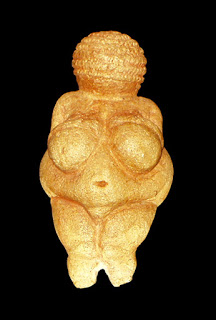 Gravettian Venus |
Below are a number of pictorial representations, very rough but based on recent drawings, archaeological findings and reconstructions, found in the internet, on the evolving race of Europeans. Keep in mind that these pictorial images bring out what are known as "surface differences" in racial characteristics related to skin color, shape of nose and eyelids, hair and eye color.
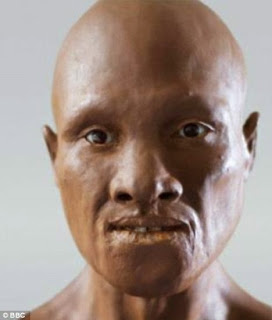
1. Reconstruction of early Upper Paleolithic in Europe based on a cranium from Romania which is 40,000 years old. He is known as the "first European".
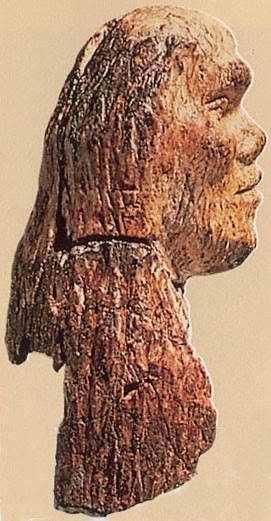
2. 26,000 year old ivory head from Europe. Notice brow ridges, heavy jaw and wider nose.
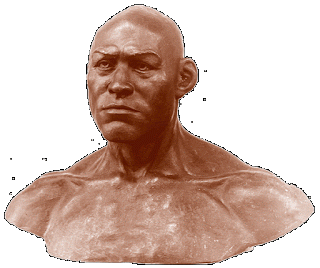
3. Reconstruction of Sunghir Man from an Upper Paleolithic site in Russia about 190 km East of Moscow, dated to approximately 25,000 years BP

4. Reconstruction of Mesolithic hunter-gatherer, who is dated to 7,000 years ago and comes from La Braña-Arintero, Spain. Not known for certain whether eyes were blue; they know they were not brown, but possibly hazel or green. The skin is portrayed as brown.
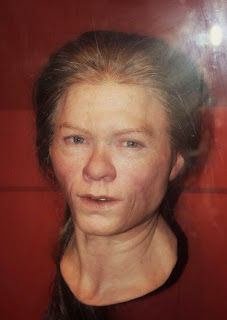
5. Reconstruction of the 'Bäckaskogswoman' from Skåne, Sweden. She died between 7010 and 6540 BC.
Media Reactions to the Discovery that Europeans Became White Recently
Basically, the narrative has been to manipulate Europeans into thinking they were not the ancestral people of Europe since the genes associated with white skin, and traits like ability to digest milk as adults, as well as tallness, were either brought into Europe by "immigrants" who arrived relatively recently or were traits that evolved much later than previously thought. Since the new research seems to say that the "original Europeans" did not not evolve lighter skin soon after leaving Africa and arriving in the colder climes of Europe starting around 40,000 years ago, but remained African-looking through the most of the Upper Paleolithic period, it would seem to follow that current Europeans are a later epiphenomenon preceded by the true African founders.
This is the implied message of one of the most widely available articles in the web, with the title How Europeans Evolved White Skin. It states in the opening paragraph:
Most of us think of Europe as the ancestral home of white people. But a new study shows that pale skin, as well as other traits such as tallness and ability to digest milk as adults, arrived in most of the continent relatively recently.
Apparently, not just North America, Australia, and New Zealand, but Europe too is not the homeland of whites. It was only after 7000 years ago that white skin "arrived" in Europe. Europeans have no right to complain about immigration-replacement by Africans and Asians.
Before this scientific finding on the evolution of a white skin gene, it was assumed that lighter skin was a superficial trait that evolved gradually but steadily once Upper Paleolithic peoples spread in Europe, so that from the time they left Africa 50,000/60,000 years ago, to the time they colonized Europe, and steadily eliminated the Neanderthals, they evolved lighter skin some 40,000 years ago. Lighter skin, it was argued, was selected as a more efficient pigment for the synthesization of vitamin D from the lower UV light environment in Europe. But now analysis of the DNA of a skeleton from La Braña-Arintero, Spain, dated 7,000 years ago (Image #4 above), shows that it was from a male who had blue eyes but dark skin.
The finding implies that for most of their evolutionary history, Europeans were not what many people today would call 'Caucasian'.
Hear that? Europeans were not white for most of their history; the prehistoric inhabitants of Britain and Scandinavia, scientists are now saying, had a dark skin tone until about 5,500-5,200 year ago, but then their diets changed from hunting and gathering wild plants to the consumption of cereals, as farming was adopted, and this is what led to the rapid evolution of light skin. The new grain diet from farming lacked vitamin D, and so lighter skin was selected as a more efficient way to synthesize vitamin D from the sun. These dietary changes were brought by the spread of a farming culture which originated in the Near East.
However, depending on the "science news" one reads, we are also informed that genes for light skin, blond hair, and blue eyes may have evolved already among hunter-gatherers in north Europe before farming arrived. Thus, an archaeological site in Motala, Sweden, dated to 7,700 years ago contained skeletons with genes for light skin, blue eyes, and blond hair. It was the inhabitants of central and southern Europe, it is argued in some science reports, who remained dark until Neolithic farmers from the Near East with a white skin gene colonized these areas with their farming technologies. This white gene was selected in Europe as the lower vitamin D grain diet from the Near East spread.
All in all, the impression one gets from reading many of the articles announcing these findings is that whites are a blip in the annals of the genetic history of Europe, a temporary, rather late phenomenon in a continent that was inhabited by a people that were African-like through most of the continent's history.
Was He Really the "First European"?
Some critics of immigration reacted with disbelief at the African-like reconstruction (by Dr. Richard Neave, see (image #1 above) of an early Upper Paleolithic skull in Europe as a distortion of the actual profile of the "first Europeans". The late Lawrence Auster thus commented in Mathilda's Archeology Blog:
Can you not think of a reason Neave made it so dark? Are you not aware of the overwhelming moral compulsion that people in our society have to put the black race at the center of things, even to go so far as to claim that the early Europeans were African blacks?
Mathilda equivocated without a clear response to Auster. There is no question the media used this reconstruction to put Africans at the center of European ancestry, with the British anthropologist Dr. Alice Roberts gushing over the reconstruction, and going to Africa to trace her ancestral roots, for a BBC documentary called "The Incredible Journey", which aired in 2009.
Nevertheless, the fact that this early Upper Paleolithic inhabitant of Europe was black, and that white skin was a later evolutionary acquisition, actually supports our side of the debate. There has been biological change in humans since Homo sapiens sapiens left Africa some 50,000 years ago; the cultural Marxist view that human genetic evolution somehow came to a halt after Homo sapiens sapiens migrated out of Africa, as Stephen Jay Gould and Richard Lewontin argued, and as the entire establishment today continues to insist, has been falsified.
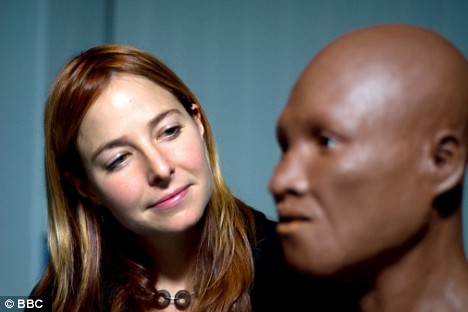
Anthropologist Alice Roberts: I look at that face and think "I'm actually looking at the face of [my ancestors] from 40,000 years ago."
The face Alice is looking at was neither the "first European" nor the first inhabitant of Europe. The Neanderthals (who evolved from Homo erectus, a species that migrated out of Africa over a million years ago) were the first. The early Upper Paleolithic people are best identified as the first Homo sapiens sapiens who settled in Europe from Africa via the Near East. It would take many thousands of years, under dramatically different ecological pressures in Europe, for these migrants to evolve into true natives of Europe.
I need hardly say that we are only scratching the surface of knowledge at this point, as we don't know much about when other racial traits and differences may have evolved in Europe such as rate of physical maturation, gestation period, more details about body built, blood types, resistance and susceptibility to various diseases, and brain size. However, in his book, Understanding Human History (2007), Michael Hart offers a very useful hypothetical computer model estimating the evolution of IQ among humans in different regions of the earth after humans migrated out of Africa. The model assumes that the first Homo sapiens sapiens out of Africa had an averaged IQ of 70, in light of the fact that there are many groups living in sub-Sahara African today with such an average IQ. From this point, he offers a chronology of the evolution of IQ outside Africa, coming up with the following hypothetical numbers for south and north Europe, and Russia:

Now, Hart notes that while rapid technological changes occurred from the beginning of the Upper Paleolithic era, leading to the invention of sewing needles and cave paintings during the Aurignacian era, and of bow and arrow during the Solutrean era, most of the innovations occurred during the Magdalenian era, lasting from 18,000 to 11,000 years ago, such as harpoons fishhooks, spear throwers and pottery, when the average IQ had risen above 90.
Were the Magdalenians the first Europeans?
"Mass Migration of Aryans from Russia Contributed a Lot to the Genetics of Europeans"
Of course, this is not how the media framed the second major finding about the genetic history of Europeans, namely, that a mass migration 4,800 years ago of pastoralists from southern Russia contributed up to 50% of ancestry in some north Europeans. To the contrary, it framed this finding in such a way that Europeans would be seen as a "mixed" racial group consisting of not only Upper Paleolithic Africans and Near Eastern farmers, but also of immigrants known as "Yamnaya pastoralists" from the Asian steppes. According to a BBC article, this "third ancestral group" of Yamnaya people should be "added to the melting pot" of ancient Europe.
Now, if we just concentrate on the science of these findings, we learn both that a culture originally from southern Russia, the Yamnaya, contributed up to 50% of the ancestry of some northern Europeans, and that the lineage of the Corded Ware people, located in north-central Europe, existing around the third millennium, were genetically close to the Yamnaya population. Roughly speaking, the genetic link between today's European population and the pastoral societies that migrated to Europe from southern Russia, or, to be more accurate, from present-day Ukraine, is around 50% of the gene pool in Northern and Central Europe, and around 25% in the Iberian Peninsula.
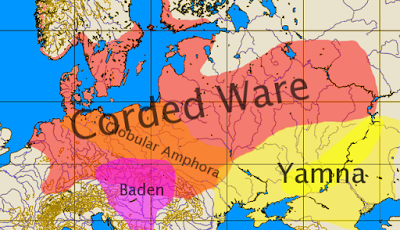
Corded Ware culture area
When we consider all the findings I have outlined above, this is the actual "mixed" picture we should be getting: the ancestors of Europeans consist of
1. Upper Paleolithic peoples in Europe who became white,
2.Near Eastern farmers who are racially classified as "Caucasian" and brought a white gene to Europe, and
3. Yamnaya people, that is Indo-European speakers, the legendary Aryans, who came to Europe starting 4,800 years ago, after this population had also evolved white traits.
But it is not just the mainstream media that engages in deception, even scientific journals use cultural Marxist expressions; for example Nature, an "International Weekly Journal of Science", writes of Europe as a "melting pot" in which Near Eastern farmers encountered blue eyed hunter gatherers "who arrived from Africa more than 40,000 years ago", joined later by a "more mysterious population" of "Eurasians" (Yamnaya).
Another article published in Nature in September 2014, a very technical paper authored by numerous scientists under the title Ancient Human Genomes Suggest Three Ancestral Populations for Present-day Europeans, did not even used the term "Indo-European" for this third ancestral population coming from Russia, but instead identified it as a population "related to Native Americans". Whether there were some genetic links between the Yamnaya and the Mongoloids of Siberia who crossed the Bering straight some 15, 000 years ago, is not the relevant issue, just as the relevant issue is not that Europeans have genetic links with Upper Paleolithic Africans; the issue is that Indo-Europeans were a later evolutionary phenomenon which diverged from the Mongoloids, or from the Upper Paleolithic peoples who arrived there originally from Africa.
Indo-Europeans were not "immigrants" and not a "mysterious" people who came from outside to join a European "melting pot"; they were instead an essential Aryan ingredient. Once the Indo-Europeans had evolved and then spread throughout the eastern, Asian side of the steppes, both as Iranian speakers and as Tocharian speakers, entering the Tarim Basin, they were "fair-skinned and light-haired people".

The Tocharians, a Caucasian people that expanded out into the Tarim basin,Western parts of China. They were an Indo-European people, with the standard fair skin and light hair. The oldest mummy, called the beauty of Loulan, dates at about 4,000 years old.
[...]
Read the rest: eurocanadian.ca
